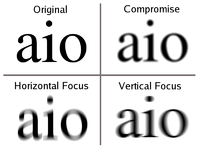
Photo from wikipedia
Including posterior corneal astigmatism (PCA) into consideration may increase the accuracy of astigmatism correction after corneal refractive surgery. In the present study we aim to investigate the distribution pattern of… Click to show full abstract
Including posterior corneal astigmatism (PCA) into consideration may increase the accuracy of astigmatism correction after corneal refractive surgery. In the present study we aim to investigate the distribution pattern of PCA in a large number of myopic patients from multiple ophthalmic centers. There were 7829 eyes retrospectively included in the study. Pentacam data of the eyes were retrieved from the machine and only results with image quality labelled with ‘OK’ were included. Distribution of PCA was slightly positively skewed (Skewness = 0.419, Kurtosis = 0.435, KS P < 0.0001). Mean PCA was 0.34 ± 0.14 D (range: 0.00 D-0.99 D). PCA was ≥ 0.25 D in 74.91% of the eyes and was ≥ 0.50 D in 11.61% of the eyes. In 97.55% of the eyes the steep meridian of PCA was vertical (SMV). PCA magnitude was significantly higher in eyes with SMV PCA (P < 0.0001) or high manifest astigmatism (MA, P < 0.0001). There was a significant correlation between anterior corneal astigmatism (ACA) magnitude and PCA magnitude in all of the eyes (r = 0.704, P < 0.0001). There was also a trend of decreasing frequency and magnitude of SMV PCA with aging (both P < 0.0001). In conclusion, PCA is present in myopic patients having corneal refractive surgery and PCA magnitude is increased with higher MA or ACA. Consideration of the impact of PCA on laser astigmatism correction may be necessary.
Journal Title: Scientific Reports
Year Published: 2020
Link to full text (if available)
Share on Social Media: Sign Up to like & get
recommendations!